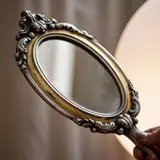
Beauty's Timeless Guide

The Art of Beauty was published in 1825, intended as a guide to those seeking a better understanding of physical beauty and its ideals. The guide includes diet advice, cosmetic recipes, descriptions of physical form, and historical examples of feminine beauty.
But how important is physical beauty, really? Studies reveal that body dissatisfaction is prevalent among American girls, with 53% of 13-year-olds and 78% of 17-year-olds expressing unhappiness with their bodies. In contrast, only 43% of teens overall and 38% of women in their 60s reported body satisfaction.
Lest you fear that ideal beauty be narrow and exclusive, take some reassurance from The Art of Beauty:
Discarding the erroneous and absurd opinion entertained by some painters and critics, that only one size and figure can be beautiful, and that all deviations from this ideal form and size must approach to deformity,--we say, that the forms of beauty in the human figure are as infinite as the varieties of human genius; and that the majestic commanding beauty can no more be compared with the winning enchanting beauty, than the genius of Sir Isaac Newton can be compared with that of Shakspeare, however nearly these may agree in a few points of minor moment. We admire the sprightly beauty no less than the modest retiring beauty; and though Campbell has pronounced that “Beauty's tears are lovelier than her smile,” we should be disposed to reject his decision of preference, on the same principle.
You will perceive from this, that we do not mean to attempt impossibilities, such as reducing the stature and form of a majestic beauty, to the little delicate figure of the Venus de Medicis; nor to enlarge the proportions (in foolish opposition to nature) of a diminutive beauty, to the classical dimensions of the Trojan Helen. All those varieties of beauty may each be exquisite, and unsurpassed within their own proper sphere; and we shall, therefore, bend our attention to assist, rather than to thwart, the several varieties of beauty, which nature has kindly bestowed on all our fair readers.
How ironic it is that a 19th century beauty guide has taken the position against the notion of a single ideal beauty standard. It asserts that beauty comes in many forms and sizes, just like human genius. The authors emphasize the importance of embracing individual beauty and avoiding artificial alterations that may detract from it. Instead, the focus should be on enhancing and celebrating the unique beauty of each person. You do not need to alter your beauty; seek instead to enhance it.